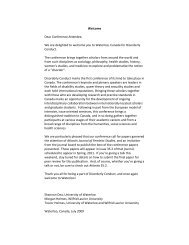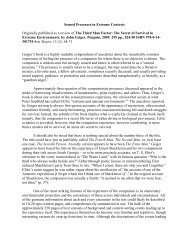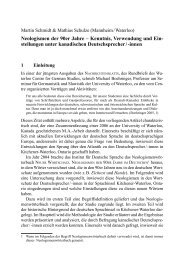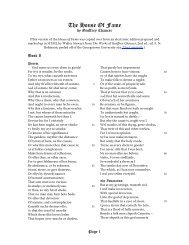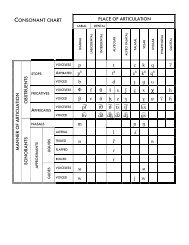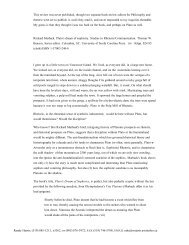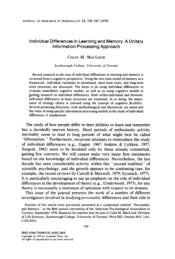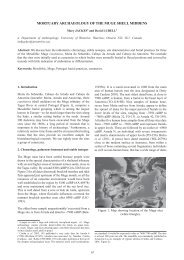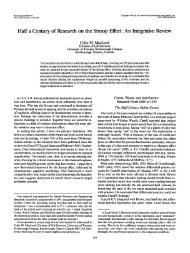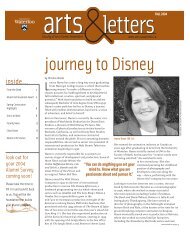The mid seventeenth century collapse of Iroquoian Ontario:
The mid seventeenth century collapse of Iroquoian Ontario:
The mid seventeenth century collapse of Iroquoian Ontario:
Create successful ePaper yourself
Turn your PDF publications into a flip-book with our unique Google optimized e-Paper software.
the Mid Seventeenth centuRy collapSe <strong>of</strong> iRoquoian on ta R i o<br />
quality available to Neutral flint knappers, but it is easy to work (Long, 2004). <strong>The</strong> suggestion<br />
is, then, <strong>of</strong> people using the local quarry and resident for at least some time at Grimsby.<br />
<strong>The</strong> remaining possibility is thus <strong>of</strong> an aggregation <strong>of</strong> people through special circumstances,<br />
with the dead lost through devastating events, close in time, perhaps a combination<br />
<strong>of</strong> disease and famine. Nevertheless, the postulated events left participants in the ceremony<br />
for the dead able to carry through a complex ritual, with family members surviving and able<br />
to identify the bones. Note again that the skeletons were without cut marks, indicating that a<br />
certain length <strong>of</strong> exposure time is necessary to account for the degree <strong>of</strong> disarticulation.<br />
Feature 62 provides evidence <strong>of</strong> a society undergoing great disruption through the almost<br />
simultaneous loss <strong>of</strong> many individuals, members <strong>of</strong> specific families, disabled people, older<br />
adult males, individuals <strong>of</strong> status. <strong>The</strong>se people were apparently grouped together during a<br />
time <strong>of</strong> increased mortality. Had they, in fact, come together in an area that provided sanctuary?<br />
It should be emphasized that the situation illustrated by Feature 62 is not one <strong>of</strong> total<br />
social breakdown. Such breakdown was vividly described by a Jesuit, when he wrote <strong>of</strong> the<br />
Huron on 13 March 1650:<br />
Doubtless the teeth <strong>of</strong> the starving man make no distinction in food, and do not recognize in the dead<br />
body him who a little before was called, until he died, father, son, or brother. Nay, more, even the dung<br />
<strong>of</strong> man or beast is not spared. Fortunate are they who can eat the food <strong>of</strong> swine,—bitter acorns, and<br />
husks (JR, 35, p. 21, see also p. 89).<br />
<strong>The</strong> Huron were brought to such a state by famine exacerbated by disease and by war. An<br />
indication that the Neutral may have come to fear the same fate, and perhaps suffer something<br />
close to it, is provided by Feature 1 at Grimsby.<br />
More than 17 individuals were buried in Feature 1 (the minimum number <strong>of</strong> individuals<br />
count was based on innominates). Although the excavators described “discrete bundles”, all<br />
individuals were probably incomplete. Two lacked skulls, and there were several bundles<br />
containing extra arms or legs, as well as much “stray” bone. Feet and hands were lacking:<br />
they were missing even in some <strong>of</strong> the single burials at the site, probably due to the Neutral<br />
practice <strong>of</strong> delayed primary burial. But the individuals in Feature 1 are generally more incomplete<br />
and mixed than elsewhere in the cemetery. <strong>The</strong> Fe 1/33 bundle, mentioned above,<br />
provides an illustration <strong>of</strong> the confused disarray <strong>of</strong> the grave. Most <strong>of</strong> the bones belonged to<br />
one male, but fragments <strong>of</strong> a child and isolated elements <strong>of</strong> at least two other adults were<br />
included. Some <strong>of</strong> the fragments <strong>of</strong> the male had been buried at a lower level than the main<br />
portion <strong>of</strong> the bundle, but they could be reconstructed and thus had been broken before<br />
burial. This suggests that burial was delayed longer than usual, that skeletons were scattered<br />
and mixed in a period before burial, and that interment was a hurried affair without the<br />
normal care and ceremony.<br />
If the bead phase IIIa features appear to suggest an influx <strong>of</strong> people, especially women<br />
and children, whether captives or refugees, bead phase IIIb – representing the last period <strong>of</strong><br />
the use <strong>of</strong> the Grimsby cemetery – seems to indicate high mortality and social disruption.<br />
365



